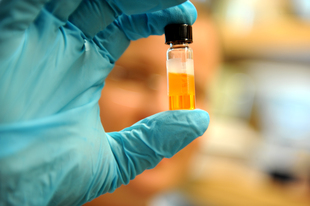Home > Press > New ‘Electronic Glue’ Promises Cheaper Semiconductors
 |
| Credit:Dan Dry A vial of nanocrystals in solution, which serve as "electronic glue" for semiconductor-based technologies. |
Abstract:
Researchers at the University of Chicago have developed an "electronic glue" that could accelerate advances in semiconductor-based technologies, including solar cells and thermoelectric devices that convert sun light and waste heat, respectively, into useful electrical energy.
New ‘Electronic Glue’ Promises Cheaper Semiconductors
Chicago, IL | Posted on June 11th, 2009Semiconductors have served as choice materials for many electronic and optical devices because of their physical properties. Commercial solar cells, computer chips and other semiconductor technologies typically use large semiconductor crystals. But that is expensive and can make large-scale applications such as rooftop solar-energy collectors prohibitive.
For those uses, engineers see great potential in semiconductor nanocrystals, sometimes just a few hundred atoms each. Nanocrystals can be readily mass-produced and used for device manufacturing via inkjet printing and other solution-based processes. But a problem remains: The crystals are unable to efficiently transfer their electric charges to one another due to surface ligand--bulky, insulating organic molecules that cap nanocrystals.
The "electronic glue" developed in Dmitri Talapin's laboratory at the University of Chicago solves the ligand problem. The team describes in the journal Science how substituting the insulating organic molecules with novel inorganic molecules dramatically increases the electronic coupling between nanocrystals. The University of Chicago licensed the underlying technology for thermoelectric applications to Evident Technologies in February.
Citation: "Colloidal Nanocrystals with Molecular Metal Chalcogenide Surface Ligands," Maksym V. Kovalendo, Department of Chemistry, University of Chicago; Marcus Scheele, Molecular Foundry, Lawrence Berkeley National Laboratory; and Dmitri V. Talapin, Department of Chemistry, University of Chicago, and Center for Nanoscale Materials, Argonne National Laboratory, Science, June 12, 2009.
Funding sources: American Chemical Society Petroleum Research Fund, the Chicago Energy Initiative, U.S. Department of Energy and Evident Technologies Inc.
####
For more information, please click here
Contacts:
Steve Koppes
773-702-8366
Scientific Contact:
Dmitri Talapin
773-834-2606
Sources not involved in the research who can comment:
Geoffrey Ozin
Professor of Material Chemistry
University of Toronto
416-978-2082
Nicholas Kotov
Professor of Chemical Engineering
University of Michigan
734-763-8768
Copyright © Newswise
If you have a comment, please Contact us.Issuers of news releases, not 7th Wave, Inc. or Nanotechnology Now, are solely responsible for the accuracy of the content.
| Related News Press |
News and information
![]() Researchers develop molecular qubits that communicate at telecom frequencies October 3rd, 2025
Researchers develop molecular qubits that communicate at telecom frequencies October 3rd, 2025
![]() Next-generation quantum communication October 3rd, 2025
Next-generation quantum communication October 3rd, 2025
![]() "Nanoreactor" cage uses visible light for catalytic and ultra-selective cross-cycloadditions October 3rd, 2025
"Nanoreactor" cage uses visible light for catalytic and ultra-selective cross-cycloadditions October 3rd, 2025
Chip Technology
![]() Lab to industry: InSe wafer-scale breakthrough for future electronics August 8th, 2025
Lab to industry: InSe wafer-scale breakthrough for future electronics August 8th, 2025
![]() A 1960s idea inspires NBI researchers to study hitherto inaccessible quantum states June 6th, 2025
A 1960s idea inspires NBI researchers to study hitherto inaccessible quantum states June 6th, 2025
![]() Programmable electron-induced color router array May 14th, 2025
Programmable electron-induced color router array May 14th, 2025
Discoveries
![]() Researchers develop molecular qubits that communicate at telecom frequencies October 3rd, 2025
Researchers develop molecular qubits that communicate at telecom frequencies October 3rd, 2025
![]() Next-generation quantum communication October 3rd, 2025
Next-generation quantum communication October 3rd, 2025
![]() "Nanoreactor" cage uses visible light for catalytic and ultra-selective cross-cycloadditions October 3rd, 2025
"Nanoreactor" cage uses visible light for catalytic and ultra-selective cross-cycloadditions October 3rd, 2025
Announcements
![]() Rice membrane extracts lithium from brines with greater speed, less waste October 3rd, 2025
Rice membrane extracts lithium from brines with greater speed, less waste October 3rd, 2025
![]() Researchers develop molecular qubits that communicate at telecom frequencies October 3rd, 2025
Researchers develop molecular qubits that communicate at telecom frequencies October 3rd, 2025
![]() Next-generation quantum communication October 3rd, 2025
Next-generation quantum communication October 3rd, 2025
![]() "Nanoreactor" cage uses visible light for catalytic and ultra-selective cross-cycloadditions October 3rd, 2025
"Nanoreactor" cage uses visible light for catalytic and ultra-selective cross-cycloadditions October 3rd, 2025
Energy
![]() Sensors innovations for smart lithium-based batteries: advancements, opportunities, and potential challenges August 8th, 2025
Sensors innovations for smart lithium-based batteries: advancements, opportunities, and potential challenges August 8th, 2025
![]() Simple algorithm paired with standard imaging tool could predict failure in lithium metal batteries August 8th, 2025
Simple algorithm paired with standard imaging tool could predict failure in lithium metal batteries August 8th, 2025
Research partnerships
![]() Lab to industry: InSe wafer-scale breakthrough for future electronics August 8th, 2025
Lab to industry: InSe wafer-scale breakthrough for future electronics August 8th, 2025
![]() HKU physicists uncover hidden order in the quantum world through deconfined quantum critical points April 25th, 2025
HKU physicists uncover hidden order in the quantum world through deconfined quantum critical points April 25th, 2025
Solar/Photovoltaic
![]() Spinel-type sulfide semiconductors to operate the next-generation LEDs and solar cells For solar-cell absorbers and green-LED source October 3rd, 2025
Spinel-type sulfide semiconductors to operate the next-generation LEDs and solar cells For solar-cell absorbers and green-LED source October 3rd, 2025
![]() KAIST researchers introduce new and improved, next-generation perovskite solar cell November 8th, 2024
KAIST researchers introduce new and improved, next-generation perovskite solar cell November 8th, 2024
![]() Groundbreaking precision in single-molecule optoelectronics August 16th, 2024
Groundbreaking precision in single-molecule optoelectronics August 16th, 2024
![]() Development of zinc oxide nanopagoda array photoelectrode: photoelectrochemical water-splitting hydrogen production January 12th, 2024
Development of zinc oxide nanopagoda array photoelectrode: photoelectrochemical water-splitting hydrogen production January 12th, 2024
|
|
||
|
|
||
| The latest news from around the world, FREE | ||
|
|
||
|
|
||
| Premium Products | ||
|
|
||
|
Only the news you want to read!
Learn More |
||
|
|
||
|
Full-service, expert consulting
Learn More |
||
|
|
||








